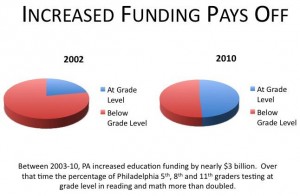A new voice has joined the chorus calling for well-funded schools, and it comes from one of the most respected economic organizations in the world. The National Bureau of Economic Research [NBER], whose current and past membership counts 24 Nobel Prize winners in Economics and 13 past chairs of the President’s Council of Economic Advisers, released a new study that confirms just how important it is that we restore education funding, and continue the annual raise of the past decade, if we want to restore these gains. PCCY has long advocated for increased spending on education. It is the single most important tool we have to improve our schools. In August, we showed how by increasing funding every year from 2003 to 2010, we were able to raise the number of Philadelphia students testing at “grade-level” in both reading and math from 22% to 49%. Unfortunately, much of these gains were erased by Harrisburg’s draconian education cuts.
PCCY has long advocated for increased spending on education. It is the single most important tool we have to improve our schools. In August, we showed how by increasing funding every year from 2003 to 2010, we were able to raise the number of Philadelphia students testing at “grade-level” in both reading and math from 22% to 49%. Unfortunately, much of these gains were erased by Harrisburg’s draconian education cuts.
Now, According to the NBER study, “a 10 percent increase in per-pupil spending each year for all twelve years of public education leads to 0.27 more completed years of education, 7.25 percent higher wages, and a 3.67 percentage-point reduction in the annual incidence of adult poverty.” To put that in perspective, more than one out of four students who would otherwise drop out after their junior year of high school will go on to graduate. While that is an unquestionable argument for the need for increased school funding, it does not tell the whole story.
PCCY encontrado that academic performance in poorer Pennsylvania districts lags far behind their well-funded counterparts. Well it just so happens that while increased funding does not do much for children from affluent families, the results are huge for low-income students. According to the NBER study, a yearly 10 percent increase in spending on low-income students results in “0.43 additional years of completed education, 9.5 percent higher earnings, and a 6.8 percentage-point reduction in the annual incidence of adult poverty.” It gets better. “In fact, a 25 percent increase over all school age years is sufficiently large to eliminate the attainment gaps between children from low- and high-income families.”
So here’s the problem: by eliminating Pennsylvania’s education funding formula, schools became funded by legislators, not by need. The income-based achievement gap only grew, contributing to the apparently unbreakable cycle of poverty. Low-income students in underfunded districts enter adolescence with two strikes already against them. But it does not have to be this way. And even better, it’s not too late. By reinstalling a fair funding formula and targeting consistent increases to low-income, underfunded districts, we have a chance to not only raise student achievement statewide, but to close the gap between rich and poor schools. Don’t take our word for it; listen to the some of the most respected economists in the country. This is not an option to discuss and debate; when it comes to our children’s future, it is an imperative.
